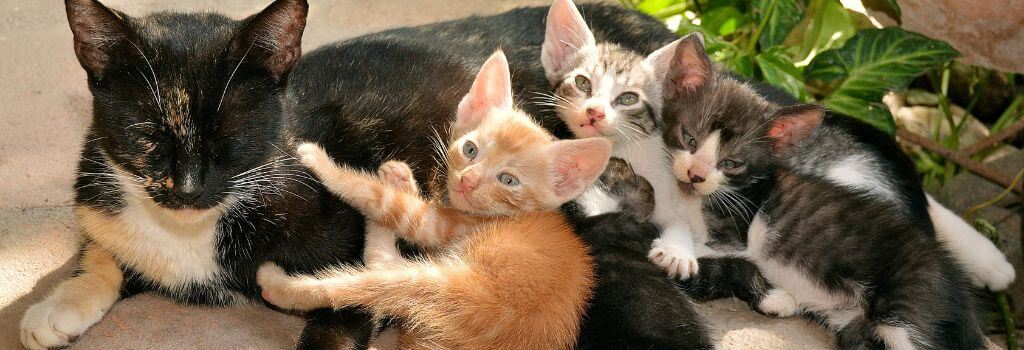Approximately 90% of adopted pets in the U.S. are spayed or neutered, and veterinarians and animal care advocates around the country continue to educate pet owners and encourage them to spay or neuter their cats. This is considered on of the most impactful decisions you will make as a pet owner. Spaying or neutering not only helps control the pet population, reducing the number of homeless animals, but it also offers numerous health and behavioral benefits for both male and female cats. From lowering the risk of certain cancers and infections to curbing unwanted behaviors like spraying and roaming, these procedures contribute to a longer, healthier, and happier life for your cat.
Spaying and Neutering for Cats Explained
Spaying and neutering have been given a number of names by pet owner communities over the years, such as "fixing" or "altering," but regardless of the name the surgical procedures remain the same.
A spay, known medically as an ovariohysterectomy, is the surgical removal of a female cat's ovaries and uterus, preventing pregnancy. Spaying will eliminate a female cat's heat cycles and prevent any behaviors commonly associated with breeding.
A neuter, also known as an orchiectomy, is the removal of a male cat's testicles, preventing reproduction. Similar to the effects of spaying on female cats, a neutered male will not experience any breeding behaviors, like roaming or testosterone-related aggression, typical to an unaltered cat.
Both procedures effectively sterilize the cat, keeping them from reproducing and adding to the rampant overpopulation issues plaguing many U.S. cities.

When to Spay & Neuter Your Cat
While spays and neuters can be done at various times throughout a cat's life, we generally recommend spaying and neutering kittens between 5-6 months old as this time frame provides the best balance of safety and health benefits.
In situations involving kitten rescue, some shelters may perform spays or neuter procedures prior to that recommended time frame in order to avoid accidental litters in young cats. However, for most cats without extenuating circumstances, 6 months remains the standard recommendation.
The Benefits of Spaying and Neutering Cats
Some pet owners feel hesitant to spay or neutering their cat, thinking it can cause negative effects on their cat's overall health and behavior. However, many of the claims against spaying and neutering are unfounded and are not supported by data in veterinary research.
Spaying and neutering have long been proven to greatly benefit cats, eliminating unwanted breed-related behaviors and preventing serious health conditions later in their life. Let's take a look at a few of the most notable benefits of spaying and neutering cats.
Reduced Cancer Risk
Spaying and neutering have been shown to drastically reduce the risk of certain types of cancer development in cats. Spaying helps prevent mammary gland, ovarian, and uterine cancer in females while neutering lowers the risk of testicular cancer in males.
For both male and female cats research has also shown that cancer prevention isn't the only health benefit. Neutering can reduce instances of prostate issues and urinary tract infections in some cats, while spaying has been shown to prevent life threatening uterine infections, like pyometra.
Decreased Roaming Behavior
Male cats are less likely to roam in search of mates when neutered, reducing the risks associated with free roaming and interacting with other outdoor or feral animals. When male cats roam in search of mates, they are likely to come into contact with other cats or animals, people, and vehicles. This can result in the spread of disease, transmission of parasites like fleas and ticks, and even injuries due to fighting amongst the cats themselves or accidents with vehicles or pesticides.
Roaming behaviors aren't just bad for your cat either; they're also bad for the environment. Cats that are allowed to roam as they please can invade and harm native ecosystems by hunting small prey. Research has estimated that as many as 4 billion birds, 22.3 billion mammals, and 1.1 billion amphibians and reptiles are killed by free-roaming cats per year in the United States.
Population Control
Cat populations across the country are ever-increasing, and non-It is currently estimated that there are around 30 to 40 million stray and unhomed cats in the U.S. Cats are prolific breeders, and when allowed to breed freely and without supervision or intervention, male and female cats can potentially contribute to the birth of hundreds of kittens throughout their life. With overcrowding already a problem in a majority of shelters, this rate of reproduction has already gone beyond what is sustainable.
By preventing unwanted litters, spaying and neutering helps to reduce the number of homeless animals and allows animal shelters and rescues to focus their resources on existing animal populations in their areas.
Reduced Aggression
For male cats, neutering can reduce a cat's desire to mark territory by spraying urine and can make them less aggressive towards other cats which ultimately leads to calmer interactions with other cats. Female cats can become less vocal and agitated when not in heat, leading to a calmer home environment. These behavioral changes are often desirable and can make living with your cat even easier.
But with this talk of behaviors changing, you may be worried about your cat's sweet or spunky disposition changing after they're spayed or neutered. The good news is, you shouldn't be; your cat's personality won't change as a result of spaying or neutering surgery. While behaviors related to reproduction may change, your cat's core personality traits like affection level or playfulness won't be affected by the procedure.
More Years with You
Yes, you heard that right – spaying and neutering may help your cat live a longer and happy life with you!
The primary way spaying and neutering cats has been linked to longer life span is because these procedures eliminate major health risks, as well as risky behavior like roaming. Data from Banfield Pet Hospital's State of Pet Health report confirmed this, finding that neutered male cats live 62% longer on average than unneutered males and spayed female cats live 39% longer than un-spayed females. According to the report, among male and female cats, life expectancy was longer for sterilized cats than intact cats.
- Life expectancy for spayed females was 13.1 years, and for intact females, 9.5 years.
- Life expectancy for neutered males was 11.8 years, and for intact males, 7.5 years.

Caring for Your Cat Before and After a Spaying or Neutering Surgery
Once you've made the responsible decision to spay or neuter your cat, you'll want to work closely with your veterinarian to make sure things go as smoothly as possible before and after surgery. While spay and neuter procedures are generally safe surgeries, and most cats recover well from them, there are a few good things to know beforehand so both you and your cat can be prepared.
Before Surgery
Your vet might instruct you to have your cat fast. This usually means withholding food for a specific period before surgery, usually after midnight, to prevent vomiting during anesthesia. It's important to ensure your vet has a complete record of your cat's health, including in medications they are currently taking. Lastly, provide a relaxing environment with minimal stress, for your cat, the night before the procedure. Don't forget to ask your vet about any other pre-surgery recommendations!
After Surgery
For optimal recovery, try to provide a quiet, comfortable space space for you cat. Ideally, it would be a smaller area to limit physical activity. To help limit physical activity, a calming medication might be prescribed by your vet. It is important to monitor the incision site and ensure there is no increased redness, swelling, discharge or other signs of infection. Contact your vet immediately if you notice excessive bleeding, lethargy, lack of appetite, fever, vomiting or difficulty urinating. Keeping your cats litter box squeaky clean will help decrease the chance of infection and overall stress. Using an Elizabethan collar (E-collar or cone) to prevent your cat from licking or scratching the incision. Initially, provide small portions of food and water to help your cat readjust to eating, and administer any ????pain medication as prescribed by your vet. Your vet will want to check on your cat's healing process, so be sure to stay on top of follow-up appointments to make sure everything is healing nicely!
If you have questions and you'd like to reach out to us, you can call us directly at (214) 833-9821, or you can email us at info@hpanimalhospital.com. Don't forget to follow us on social media Facebook, Instagram.

